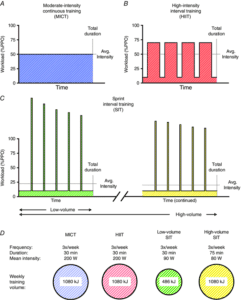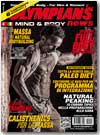Confusion over HIIT abounds it seems
For something so seemingly simple, High Intensity Interval Training (HIIT) causes far more confusion than it should in my view. Yet, we still see people out there who apparently don’t fully understand what HIIT entails and often confuse basic interval training for HIIT or HIIT for SIT! HIIT is a form of interval training but not all interval training is HIIT, and I’ll get to SIT in moment.
I suspect some of the confusion stems from the variations of HIIT and its evolution over time with different approaches and changes in terminology. For myself, back in the day, what I would have considered interval training would now be considered HIIT and what I considered HIIT would now be referred to as “sprint interval training” or SIT. Hell, even this introduction probably confused a few readers!
I will do my best to clarify it all and link to an excellent review paper at the end of this article that puts it to rest and fully covers physiological adaptations of HIT, SIT and moderate-intensity continuous training (MICT), gives recs on frequency/duration, etc. of each, covers the benefits of each, and so forth.The problem with scientists, especially for non-scientists, is science loves its terminology and acronyms and they love to either change them or create new ones just to mess with people. OK, that last part is not true, but for some, it feels that way I know. For example, MCIT is essentially the same, or at least very similar, to what most people already know as steady state low intensity (LISS) work, but one could argue moderate not identical to low intensity per se. No one splits the proverbial hair like scientists, but I digress. Don’t sweat it or over think it here.
A Common Source Of Confusion
A common source confusion between non-scientists and researchers is the term “intensity.” Scientists must use an objective measure of the term, those in the gym generally do not and will use a subjective measure and terms to describe it. This may be overly simple for some, but for others, it will really help them understand how this works and decide accordingly moving forward. In resistance training for example, an objective measure of intensity in science is your 1 rep max (1RM). For cardiovascular work, VO2 max and or a % of max heart rate is used as the objective measure of intensity there. From here on, I’m just going to use % of max heart rate (MHR) to define intensity objectively as it’s easy to figure out and easy work with, and in the real world, correlates well to VO2 max, but they are not technically the same thing or interchangeable. I’m trying to keep it as simple as possible here, so take it up with an exercise physiologist if you don’t like my oversimplification of VO2 max and MHR.
To save space, the basic formula for calculating your max HR if you plan to apply it to the HIIT recs to follow is below, but there are more precise formulas that adjust for age out there and it’s just a starting point, usually requiring some tweaking by individuals. (1)
So, in science terms, 100% intensity is your one rep max (1RM) on a lift. That’s 100% effort, so figuring out say 85% of your 1RM would typically allow approx. 4-6 reps for most people as an example. Programs will call for say 3 sets using 80% of your 1RM and so forth.
Now, a typical experienced lifter in the gym takes a moderate weight and does a set of 20 rep breathing squats, and while lying on the floor trying not to throw up, says “man that was an intense set!”
Anyone who has done a set of high rep breathing squats (quite possibly the most difficult and miserable thing you will ever experience in the gym) would tell you the “intensity” and difficulty is higher than doing 6 reps @ 80% of your 1RM, but that’s not how science defines it. Hence, the common disconnect between objective science based terminology and the average gym goer. Science requires objective measures and a paper that said “we had people do really intense sets of weight lifting” or “we had a group run really hard” would obviously be useless and the researchers laughed out of the biz.
Typical gym goers often use the term intensity and difficult as interchangeable, but that’s not how it works in science via sports physiologists doing their research. Understanding that is helpful as we move forward to get to the topic of HIIT.
So What’s HIIT?!
OK, now we get to the meat if this here discussion. From the aforementioned review paper, an excellent summary sentence:
“For simplicity and consistency, this review will employ the nomenclature put forward by Weston et al. to differentiate two basic types of interval training based on exercise intensity. High-intensity interval training (HIIT) is defined as ‘near maximal’ efforts generally performed at an intensity that elicits ≥ 80% (but often 85–95%) of maximal heart rate.
In contrast, sprint interval training (SIT) is characterized by efforts performed at intensities equal to or greater than the pace that would elicit , including ‘all-out’ or ‘supramaximal’ efforts.The term moderate intensity continuous training (MICT) is used for comparative purposes to describe exercise that is performed in a continuous manner and at lower intensities than HIIT. While imperfect, this general classification scheme is nonetheless suitable for our purposes here.”
So, two forms of HIIT really, one now called SIT. Basic rule, HIIT will have a longer higher intensity segment followed by a low intensity segment and repeated. SIT is a short lived max effort sprint, nothing held back, with no exercise in between, and of course MICT is pretty self explanatory, defined as 50% of MHR. Obviously the sprint part of the SIT will be very short lived (10-30s) as no one can put out a true max effort beyond that.
Again, back in the day, I would have viewed SIT as true HIIT and what’s HIIT above as more typical interval training and said such circa 2008 or thereabouts I recall. Sue me.
What’s interesting is they all have some unique/different effects and are all potentially worth incorporating in some fashion or another, but that’s beyond the scope of this article and there’s a ton of info in the review paper for those who want to dive deeper into the topic. Remember, HIIT/SIT is not for everyone, has a higher potential for injury and OTS than MICT/LISS and should not be done just cuz HIIT is the in thing others are doing to be in the cool kid crew as in “I did some functional training, followed by HIIT, and then kipping pull ups bro…” Please don’t be that guy (or gal). Take a little time to see how and why it may be worth incorporating into your program, which depends on your goals and other variables. For some, depending on goals and other variables, HIIT/SIT may not be beneficial to the goals.
What do I prefer? I prefer what I refer to as “classic” HIIT or what’s now termed SIT. Frankly, I don’t want to calculate my HMR and then attempt to track it while doing HIIT via an HR monitor. With SIT, it’s simple; as fast as you can possibly go in an ‘all-out’ or ‘supramaximal’ effort, done. I have always been better at producing a large output of energy for short duration and not so good at extended duration stuff so SIT suits me better physically and mentally. SIT takes less time, at least for me, and that’s another plus. For example, I’ll do 30 second all out, 1 minute of either nothing, or very slow movement, and repeat for 10-12 cycles with 2 minute warm up and maybe 5 minute cool down, and done. I’ll then do some mobility stuff and maybe some stretching.
I do not do SIT continuously, but tend to go through periods of maybe a few weeks to a month, and will reduce my volume of resistance exercise as HIIT and SIT tap heavily into your ability to fully recuperate, and that only gets more difficult with age. Whenever I see people mention their program includes doing heavy resistance work 4-5 times per week, 3-4 sessions of HIIT, and some LISS, I know they are young and consider themselves indestructible, and I know it’s only a matter of time before they get injured, seriously over train, or both.
Legit HIIT/SIT should be viewed as a workout on its own in terms of recoup and metabolic demands on the system not as an after thought. When I see people say they workout with weights then do X minutes of HIIT, either their weight training sessions are really easy, their HIIT session are easy, or both, or they are not doing legit HIIT. Unless you’re a super hero or Olympic level track athlete on PEDs, a legit session of HIIT/SIT should kick your ass. If not, re asses what you’re doing as HIIT, much less SIT.
Personally I use and recommend modalities that are non-impactive, such as a stationary bike or elliptical machine, or stair stepper kinda thing. Sprints on a track, etc., are hard on the joints and I cringe when I see someone using plyometrics and similar to do their HIIT work.
Conclusion.
Proper incorporation of HIIT/SIT into a program is a topic and article by itself and opinions vary. Me, I’m not all that focused per se on maximizing strength and FFM, so I may do 6-8 weeks typical resistance training 4 days a week with LISS, followed by 4 weeks of SIT 2-3 times per week with reduced volume on the resistance training, take a de load week, and repeat give or take as schedule and life allows. For those focused strictly on strength and increasing FFM, HIIT/SIT should be used sparingly if at all. I do incorporate SIT work in the BrinkZone Hybrid Program also.
If you have additional questions after reading this, dive into the review paper linked HERE.
See you in the gym….
(1) Standard equation is 220 – age = maximum heart rate (MHR).
Will Brink is the owner of the Brinkzone Blog. Will has over 30 years experience as a respected author, columnist and consultant, to the supplement, fitness, bodybuilding, and weight loss industry and has been extensively published. Will graduated from Harvard University with a concentration in the natural sciences, and is a consultant to major supplement, dairy, and pharmaceutical companies.
His often ground breaking articles can be found in publications such as Lets Live, Muscle Media 2000, MuscleMag International, The Life Extension Magazine, Muscle n Fitness, Inside Karate, Exercise For Men Only, Body International, Power, Oxygen, Penthouse, Women’s World and The Townsend Letter For Doctors.
He’s also been published in peer reviewed journals.
Will is the author of the popular e-books, both accompanied by private members forum access , Bodybuilding Revealed & Fat Loss Revealed.
You can also buy Will’s other books on Amazon, Apple iBook, and Barnes and Noble.








It certainly appears that Moderate Intensity Continuous Training (MICT) @ 50% of Max HR is improperly categorized and is really very low intensity according to the….
Aerobic Training Zones:
50% – 59% Zone 1 = Very Easy
60% – 69% Zone 2 = Easy
70% – 79% Zone 3 = Moderate
80% – 89% Zone 4 = Hard
90% – 100% Zone 5 = Max
For me, walking @ 3.5 MPH will only raise my heart rate into Zone 1 and is a Very Easy effort.
“The problem with scientists, especially for non-scientists, is science loves its terminology and acronyms and they love to either change them or create new ones just to mess with people.”
Will, I loved your statement, albeit in jest, above.
In that regard, I wonder if weightlifting physicists cringe every time body composition researchers use the term, “volume,” to indicate quantity of performed reps ( I think “work,” would be a better metric), in place of its scientific meaning as a unit of spatial measure.
Hi, can you please add reference for her study that showing the advantage of hiit / sit training vs aerobic activity for caloric output and fat burn, thanks
Full paper is linked above.
Really helpful article as I never knew what “SIT” was until now. Thank you
Being in your age bracket, and having worked out approx. 2 decades, this is really useful information. Out of necessity I have already drifted in the direction of combining the modalities you refer ot in the article. Sort of confirms my “feel” for how I need to work out these days. Great stuff!
Love how “trainers” act like they just invented a wonderful new thing, by calling an existing Training method by a new name, for example calling Interval training , “high intensity Interval training” (HIIT).
I believe there were several scientific papers written about the benefits of interval training in the 1890s.. yes almost 130 years ago.
It was well known that many accomplished Olympic gold medal winners in running used interval training extensively, especially the Finnish in the 1920s and 1930s, to win medals in longer distance races.
There is also a fitness writer, Craig Ballantyne , who says he invented what he calls “turbulence training”, which sounds very much like what Vince Gironda described as “peripheral heart action training” in the 1960s.
Searching for the perfect program En and supposed “breakthroughs ” is a fool’s errand, I haven’t found any that work better than the program a high school teacher wrote out for me in 1976